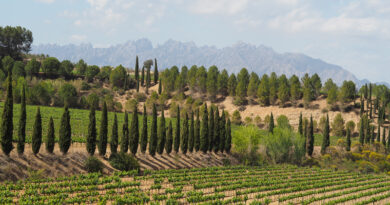In the Swartland with Eben Sadie (2) in the cellar, and tasting the wines
Jamie Goode and Treve Ring taste with Eben Sadie, and visit the winery where some of South Africa’s most sought-after wines are raised. And he’s just handed over winemaking duties to Paul Jordaan for the 2020 vintage.
We look at the winery, beginning with the first fermentation cellar where Eben started out. Now it houses the barrels containing the whole production of Columella. The room is filled with very expensive-looking fancy barrels. ‘I’m not keen on oak,’ Eben says. ‘We only have one wine that we still use small barrels for, and that’s Columella. I tried to make this wine outside new oak and it doesn’t want to be geek or hipster, it just wants to be wine.’ These 40 casks result in 12 000 bottles of Columella each year.
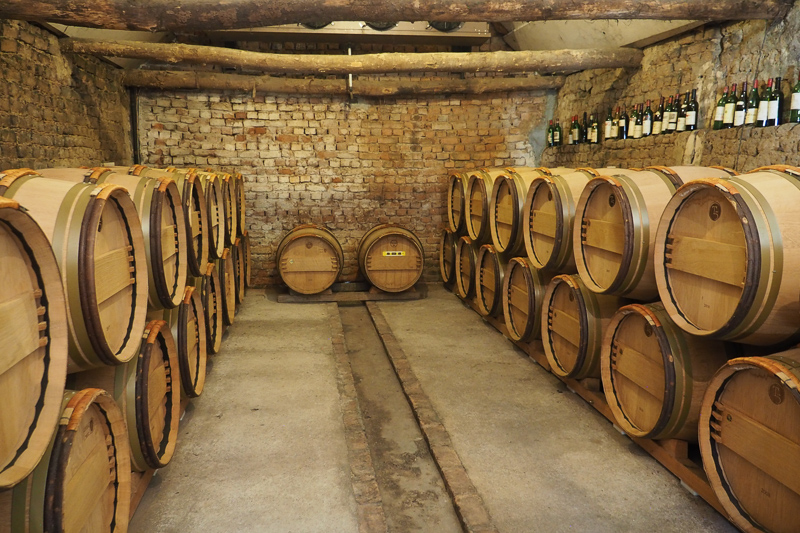
‘Columella changes every 10 years’, muses Eben. For the first 10 years it was majority Syrah and Mourvèdre, picked ripe. There were two pigeages a day, and it saw 60% new oak for 24 months. For the second 10 years he never picked over 14% alcohol. ‘In our climate, there is nothing like phenolic maturity. You only get psychological maturity, where you see the wine going.’ 70% whole bunch, no pigeage, just a bucketing over of juice every day. ‘Where we made the wine like making coffee, we now make tea. It is more fusion and simmering.’ And although it looks the same, the oak program has changed. ‘We only buy four new barrels a year, and we throw out four, and there are 40 barrels in here,’ says Eben.
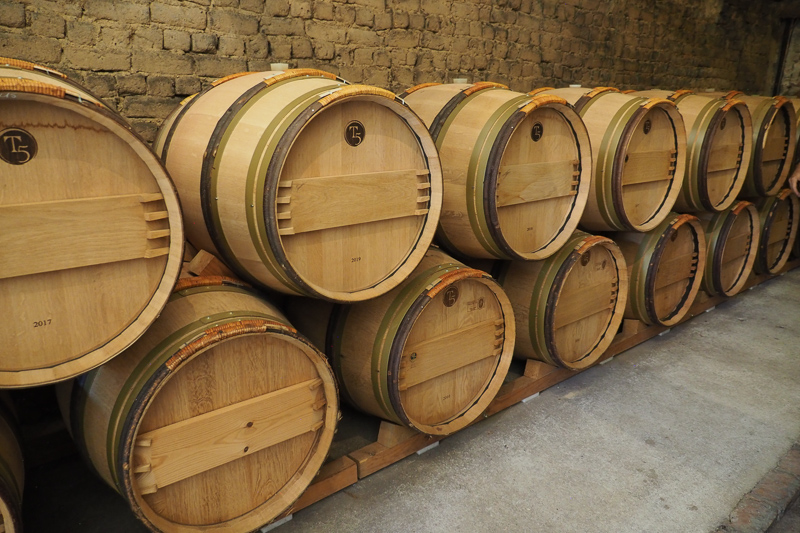
Some barrels are 10 years old. They rack the wines off after 12 months now. The second decade there was the introduction of Carignan for acid, Cinsault for fruit, Grenache for volume, and Tinta Barocca for structure. So Columella is not the same wine as it used to be. ‘In a vertical, the first decade is such a solid thing, and the second decade is such a solid thing,’ says Eben. ‘The only thing we have gained in the second decade is more youth and more vitality, greater colour stability and greater purity. I just wish I could have made the second decade with the climatic conditions of the first.’
‘People that know their wine will know how bad it is,’ says Eben, referring to the way that the climate has changed. With all the improvements in the viticulture, he says he is still struggling to meet his numbers he had between 2000 and 2004. ‘The climate has moved on 100 years for us when I look at the wines, and that is why I am very nervous. My wife says why are you so stressed? It is because although I’m trying to make it up with the human element, I can’t keep up with the race.’
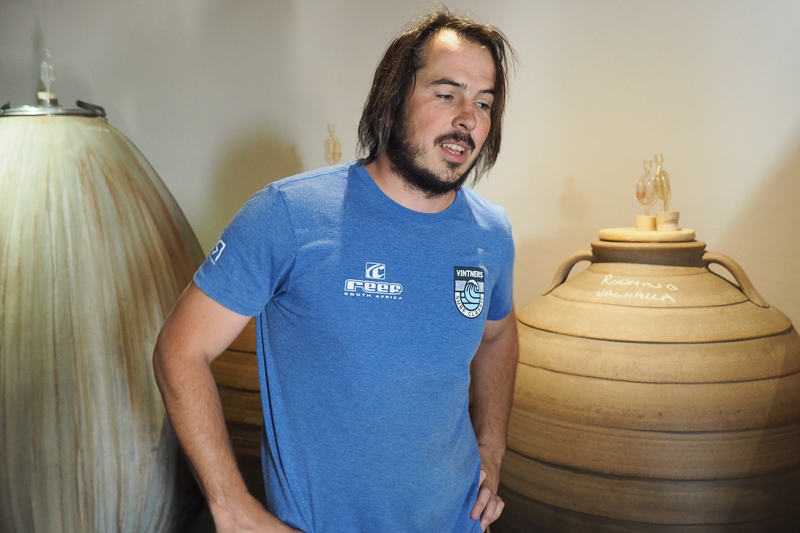
Eben has decided to step back from front line winemaking for the 2020 vintage. This year will be the first vintage where Paul Jordaan is making the decisions. ‘I will bite my lip,’ says Eben.
In the main cellar Paul is working with Eben’s younger son Zander, who has been working in France and is going to study enology the following year. They are working with some ceramic amphorae, and are busy putting blends together in advance of harvest which is around the corner.
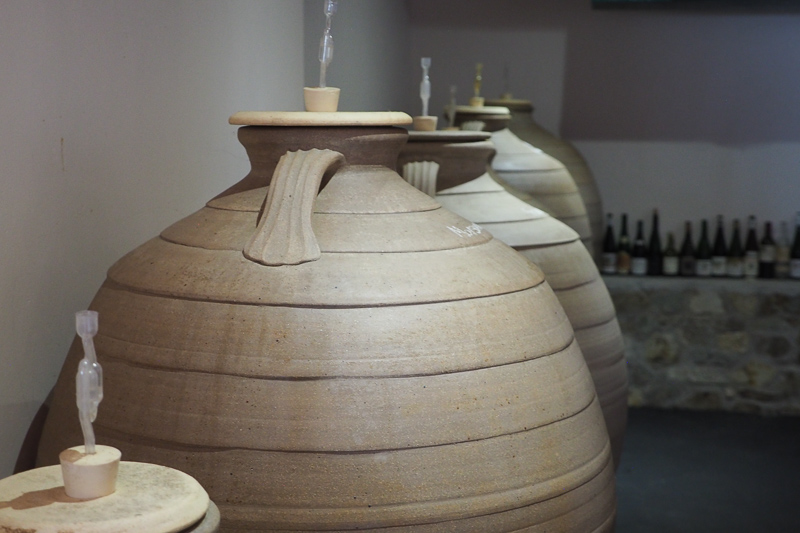
Then we head into the Palladius room, filled with clay. Palladius is 11 different varieties these days. ‘We are trying to produce appellation wines,’ says Eben. ‘But what is an appellation? If you want to make an appellation wine you need to include all the grapes in the appellation. Even grapes you don’t like. I’m not particularly in love with Viognier. I make a little bit, and I include it because it is a bit of our appellation. The blend is Chenin Blanc, Grenache Blanc, Marsanne, Roussanne, Viognier, Clairette, Semillon, Semillon Gris, Verdelho, Colombard and Palomino. Chenin is the driver. Clairette is a high acid binder. Colombard does the same thing.
The clay vessels are made in South Africa. The first ones Eben had were fired at 800 C, but they still allowed too much oxygen transmission. ‘It was only when we started reaching 1100 C the amphorae became really sound for wine.’ The different size vessels he has allows him to play with different varieties.
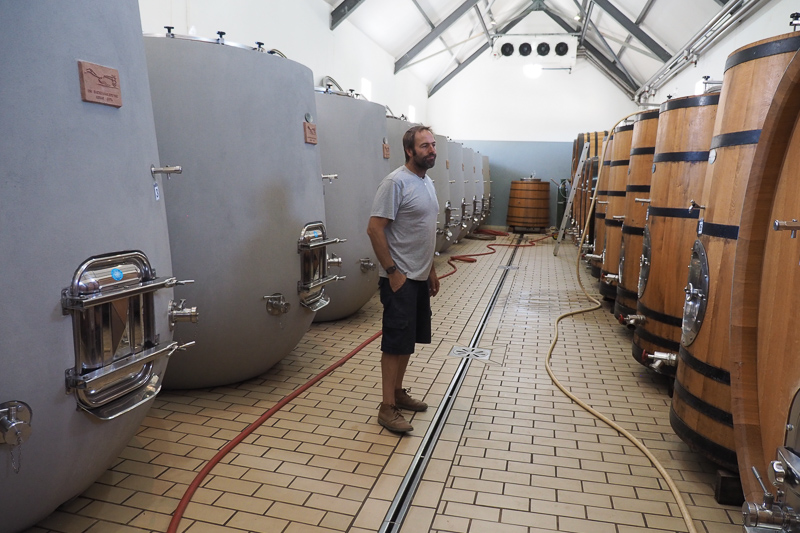
The third cellar is for all the single vineyard wines. This is all concrete and old oak. Each tank has a hectare’s worth of grapes in it. A vineyard is either one or two tanks (of 20 hectolitres each), but there are some vineyards that aren’t a hectare that are fermented in smaller tanks. He buys new large oak, puts coop wine in for a couple of years, then the wine goes back to the coop before he uses them for the old vine series.
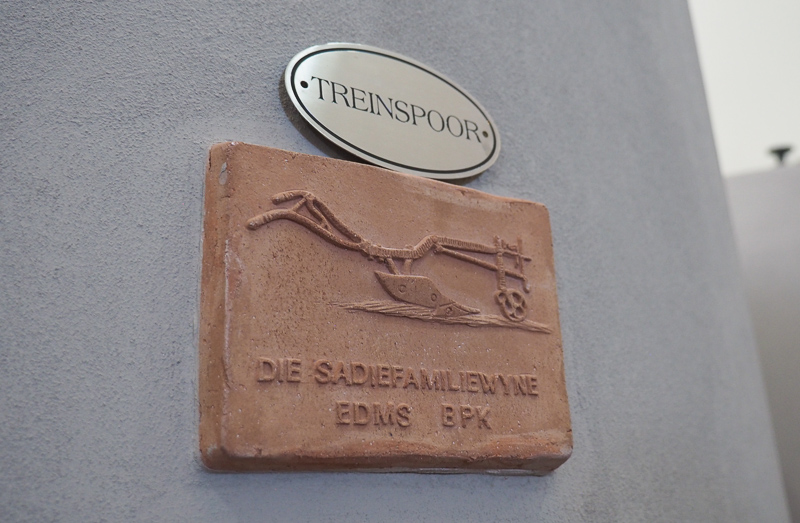
The thing that takes the longest in the cellar is the sorting. ‘We sort every bunch,’ says Eben. Production is 65 000 bottles. ‘There are seven people in management, five permanent guys on the farm, fourteen guys in the vineyard, and in the season we have 20 more people. 47 people work on 65000 bottles. Being able to do the right thing, the right way, at the right time is critical. But it is costly.’
The old vines series is 85% whole cluster. ‘The only reason we destem 15% is to get some juice into the tank to have some layer of protection, to get the ferment going,’ says Eben. ‘We did 100% whole bunch from 2011-2014, but we started running into bacterial problems. We had a bit of brettanomyces, too. I don’t like brett at all. I don’t want any of it: it’s not part of the terroir for me, although it comes on the grapes. Brett is a weird thing. I kind of like brett, but in other peoples’ wine. It is like Stelvin: I like it on other peoples’ wine.’
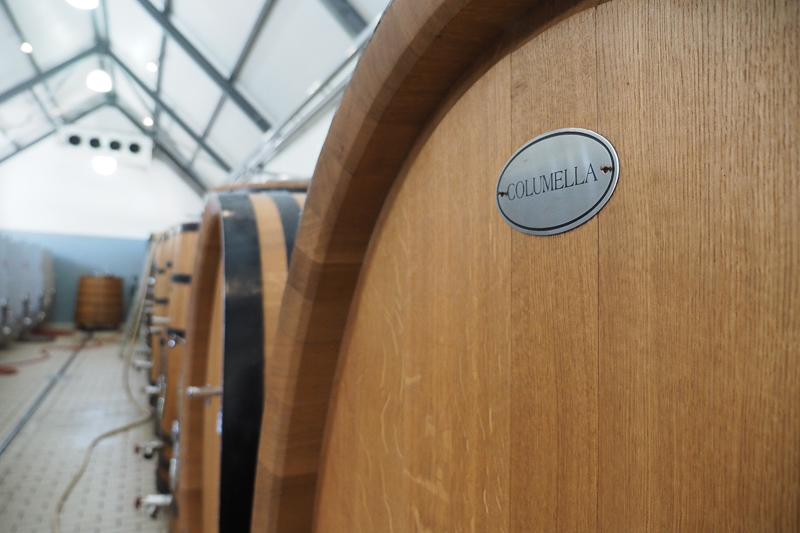
Eben’s wines are in such demand that they sell in one day. ‘When people don’t get what they want, they actually become quite vindictive, so you have to manage this,’ he says. ‘What we do is release the wines the last Monday in July.’ The orders come in and by 0845 the wine is sold out. This massive popularity creates a culture where people drink them incredibly young, he says, and they even disappear quickly from restaurant lists.
So Eben is sending more wine to retail, and stipulates that they can’t sell more than three bottles to any one customer. ‘Our two biggest customers in the world are Broadbent and FMV,’ he says. ‘Both get 8% of our production. Our next biggest customer gets 4%.’
We talked about picking decisions. ‘Now the trend in the world is the hipster movement and a lot of people are just picking earlier – but they are not farming for earlier picking,’ says Eben. ‘There is a vast difference between picking earlier and farming earlier. The wines are fresh, linear, pure, transparent – but the wine is as hollow as a donut. If you do not allow a grape to ripen to some extent, it can never express the terroir. If I am to pick all these at 12%, and this is what we have done with some of the young vines, they all taste the same. I can’t see the grape, let alone the terroir. The whole movement to get lower alcohols is great, but it involves farming younger.’
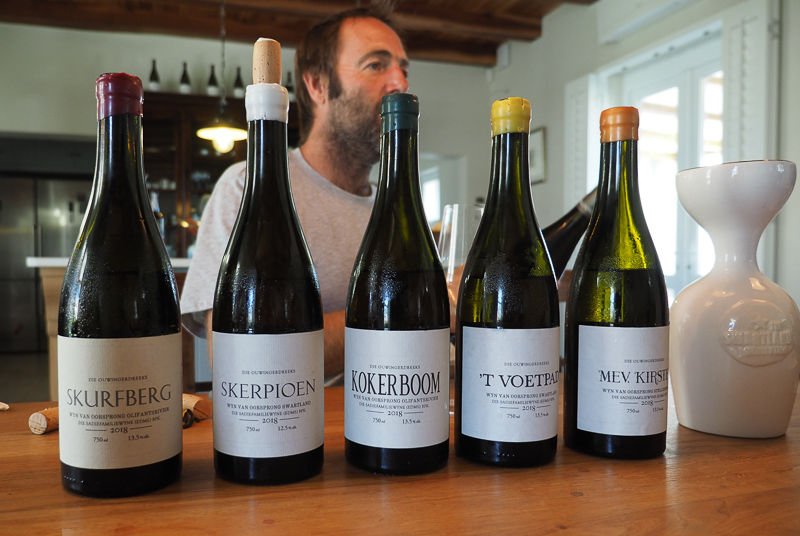
I ask: how do you farm younger? ‘Yield, pruning technique, and the site (if it is still a vineyard to be planted),’ he says. ‘Farm with cover crops. You must keep hydric stress away.’ He is currently busy writing a book for his sons about his views on agriculture. ‘In the pruning chapter, the first policy is that in severe years, we do crop thinning of one bunch to a shoot a week after flowering. If you get disease on those bunches, whatever you have is gone.’
We tasted the wines in Eben’s home, higher up the the hill, overlooking his Rotsvas estate vines. ‘When I started out I wanted to make one wine. Now I make 10.’ Ever looking ahead, he is currently writing a book about viticulture for his sons, in the hopes of sharing what he’s learned for future generations. 2020 should also see the realization of a complete terroir soils map of the Swartland, a project Eben has been working on for some time.
THE WINES
Sadie Family Wines Soldaat 2018 Piekeneerskloof, South Africa
12.9% alcohol this year. Grenache. A 42 year old vineyard planted at 708 m on decomposed granite. ‘The big realization I have made with Grenache is that normally it can be alcoholic and overpowering, but we grow this at very high altitude,’ says Eben. He worked with Grenache in Priorat. ‘When I came back from Spain I did a study and I took L’Hermita and Dani Landi’s Las Umbrias and Rayas and we built solar radiation models of the sites,’ he says. ‘Grenache wants a lot of solar radiation, but not heat. We found a place here.’ He says that 2018 was a bit different because it was a very dry year. ‘It’s the first year we had red pomegranate. Normally it is strawberries and raspberries. Grenache is an amazing grape. It is definitely on the A list for south Africa. If you look at our climatology there should be much more planted, but it’s not because consumers still drink Merlot. The best selling wine in South Africa is Merlot. Merlot uses a lot of water. So what do you do? You take a country that doesn’t have water and you plant a grape that uses the most water.’ This is fresh and detailed. A lighter-styled red with a twist of pomegranate, some wild strawberry and some raspberry. Nice spiciness, too. Fine grained tannic structure. This is so fresh and detailed. 95/100 (JG)
This ungrafted and unirrigated old bush vine Grenache comes from Piekenierskloof pass, and a sandstone-dominant 42 year-old vineyard, at 708m. The Pass was named after the foot soldiers (piekeniers) located at the top of the mountain to protect livestock from theft, hence the wine’s name of Soldaat (Soldier). This was 85% whole cluster, native fermented and aged in concrete. After extensive solar radiation studies, Eben understood that Grenache wants sunlight, but not heat. Light and fresh, detailed with wild raspberry, grippy red currant, pomegranate, and lithely structured with long, fine grained tannins that grip on the finish. Quite dry and with concentration (perhaps due to the drought years), but very fresh throughout. This wine is a great argument for planting a lot more Grenache in SA. Easy finesse, but with seriousness. 94/100 (TR)
Sadie Family Wines Pofadder 2018 Swartland, South Africa
12.8% alcohol. This is a varietal Cinsault from the Riebeeksrivier farm, owned by the Ruperts. One of the few plots Eben doesn’t farm himself. 100% decomposed slate (80% decomposed, not rocky). Red, iron-rich soil. So fresh and juicy with cherry and raspberry fruit. Crisp, elegant and juicy with real focus and brightness. Lovely red fruit quality. So expressive and has a sense of lightness. 94/100 (JG)
This Cinsault is from Riebeeksrivier farm, owned by the Ruperts family and farmed fantastically by their team (it is one of the only sites Eben doesn’t farm himself). From iron-rich decomposed slate, and vines planted in 1973, this site is picked early because it can very quickly get too ripe. Fresh and brisk, and dusted with fine iron dust, this is juicy wild raspberry and sapid pomegranate, along fine, long, lightly grippy tannins. 93/100 (TR)
Sadie Family Wines Treinspoor 2018 Swartland, South Africa
‘My favourite grape is Tinta Barocca. This is the historic grape of the Cape that belonged to the Swartland, and to me it defines terroir,’ says Eben. ‘Before phylloxera, it was extensively planted in the Douro. After, they didn’t plant the same quantitites again because it is a shy bearer. You need to blend in your head Syrah with Nebbiolo. There is no reference for Tinta Barocca.’ This is from alluvial soils with some quartz, planted in 1974. Very fine and juicy with good structure under the supple raspberry and berry fruit. Light and floral with real finesse and purity, but also good structure and spicy finesse. Syrah meets Nebbiolo, and this will age. 96/100 (JG)
Treinspoor is Tinta Barocca, Eben’s favourite grape, as it ‘defines terroir deeper’. This comes from a vineyard planted in 1974 on decomposed granite, sandstone, quartz and flint, on the western side of Malmesbury. It is located next to the old railway line (treinspoor), hence, its name. Thankfully there is quite a bit of old vine Tinta Barocca in the Swartland. Lovely wild scrub, fynbos, purple florals are pitched with fine peppery spice. Stone dusted finely grippy tannins frame this structural wine, one that has a lightness of being. Very complete and impressive now, but one that will age beautifully. Eben likens Tinta Barocca to being like Syrah and Nebbiolo in your head. 96/100 (TR)
Sadie Family Columella 2017 Swartland, South Africa
‘Columella, from the outset, had a tight script,’ says Eben. ‘It was well curated from the outset. There have been some changes but not dramatic. Columella is like the guy who plays first team football in school and dates the prom queen, gets top marks, and is good looking. But Palladius is not that: it started super ripe and super sweet. The varietals changed over a decade. That’s not terroir; it’s human.’ It took him until 2009 to change the style, then he changed it again in 2011, and paused. ‘The next stage will be the inclusion of some of the new varieties. That first 10 years, there is no terroir or climate. You can talk about those things, but it’s not the differences. It is all human.’ This is fresh and expressive with juicy raspberry and red cherry fruit as well as bright blackberry notes. Has a hint of creaminess under the vivid fruit. Complex and layered, as well as fresh, with some nice depth to it. Serious stuff, in need of some time. Will age beautifully. 95/100 (JG)
Columella is Eben’s appellation blend to represent the Swartland, and now, two decades in, it’s a fascinating historical love letter of the region. From 8 vineyards (2 in Paardeberg, 4 in Kasteelberg, and 2 in Malmesbury), and soils crossing granite, slate, gravel and sandstone, this is interplanted Syrah, Mourvèdre, Grenache, Carignan, Cinsault, Tinta Barroca. Lovely dusky cassis, wild blackberry, black plum, graphite, and perfumed peppery spices fill this concentrated, structural, yet fresh, wine. Tannins are firm and tense at this youthful stage, housing the power within. Very deep, layered and complexed, this will easily ride out 20 years before maturity. Gravitas. 95/100 (TR)
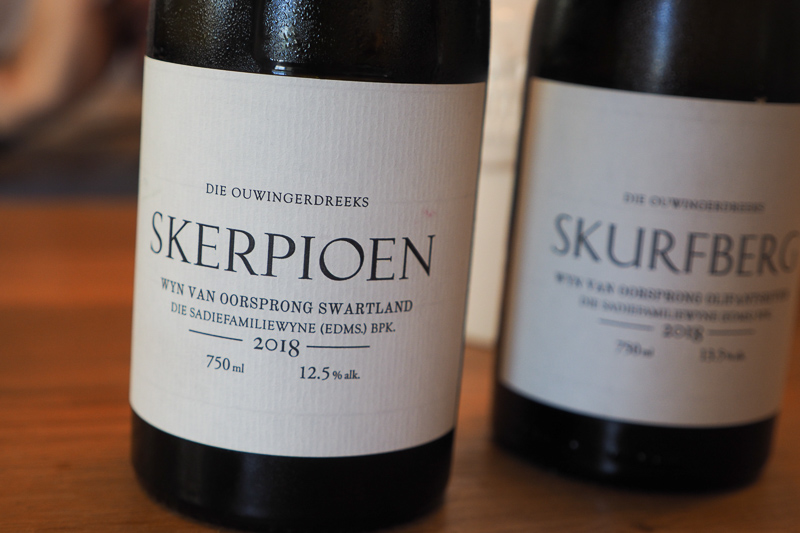
Sadie Family Wines Skerpioen 2018 Swartland, South Africa
12.5% alcohol. Just planted 7 hectares here. Co-planted vineyard on palomino and chenin planted on white limestone. Half of each variety whole-bunched pressed to old foudre and then bottled straight off the lees. A mile from the ocean. Fresh, linear and saline with nice focus. Bright citrus fruit with amazing texture and precision. Quite transparent and detailed. 94/100 (JG)
Means scorpion. Co planted vineyard of palomino and chenin on limestone. Hence the white wax top. WB pressed to older foudres, 12 months and then bottled straight off the lees. 1 mile from the ocean. 1958-67 planted. Very saline and salty, tight, grippy green apple, fine and tight lees, with the herbal lightness. Severe and tight and streamlined. 92/100 (TR)
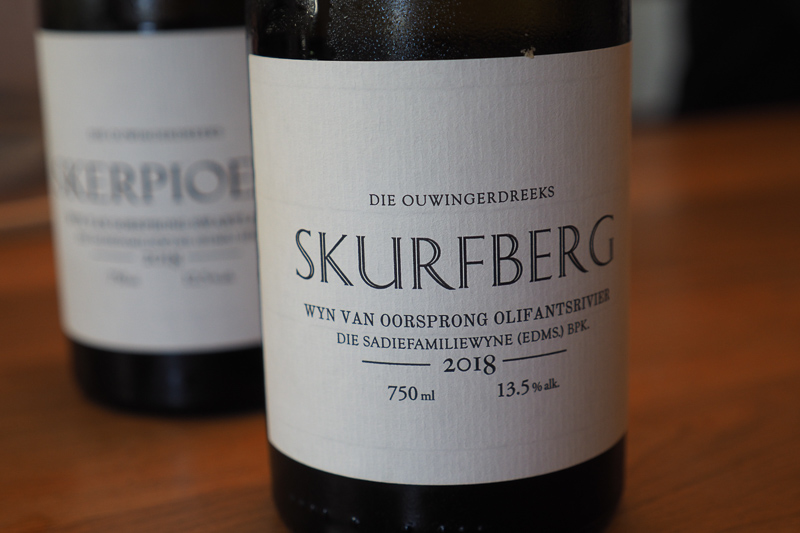
Sadie Family Wines Skurfberg 2018 Olifantsrivier, South Africa
100% Chenin. 13.3% alcohol. This is so bright and mineral with crisp, slightly saline mandarin and yellow plum fruit with some white peach and a lovely precision. Very expressive and detailed with real beauty. Very faint trace of cabbage and herb, too. Lovely. 96/100 (JG)
This Chenin Blanc ‘has been perfectly pruned for 70 years’ according to Eben, without any chemicals or herbicides. This is from 3 old bush vine parcels planted between 1940-1955 on the decomposed sandstone slopes of the Skurfberg = rigid mountain. Quince skin, white peach, broken minerals, salts and salts ring through this savoury, serious white, stretching long on the palate and haunting on the finish. Increcible layers. 95/100 (TR)
Sadie Family Wines Kokerboom 2018 Olifantsrivier, South Africa
Semillon. Some green herby notes here with a touch of cabbage. Has a fine spiciness. Grassy and lemony with a mineral undercurrent. Supple and fine, but a bit too green. Give this time to come round. 91/100 (JG)
Named for the striking aloe plants that grow near this old vineyard, this is a field blend of White Greengrape and Red Greengrape, as all versions of Semillon used to be called. The red-berried form of Sem was once common in the cape, but is rarely seen now. Planted in the Clanwilliam region in the 1930’s, this high altitude Sem is on sandstone. Green it is, with lemon verbena, green pepper, and light lemony pith spicing, with a slick of oil and lees on the tight and youthful palate. A dash of white pepper lingers on the finish. 92/100 (TR)
Sadie Family Wines ‘T Voetpad 2018 Swartland, South Africa
Field blend of vines planted between 1887 and 1928. The majority was planted in 1900. Alluvial sandstone in Picketberg. Semillons Blanc and Gris, Palomino and Chenin, as well as Muscat (just 1% now). Lovel aromatics with rich pear, peach and citrus fruit. Very fresh and layered with sweet fruit quality but also nice minerality and focused acidity. So fine and expressive, but structured too. 96/100 (JG)
‘T Voetpad means The Footpath in Dutch, and is the name of the rooibos and wheat farm next to this isolated vineyard in northern’s Swartland Pieketberg, where the block of old vines is tucked away. This is the oldest white wine vineyard in South Africa, with plantings beginning in 1887, and the majority falling between 1900-1928. These own-rooted vines are growing on alluvial sandstone, and the cofermented field blend includes Sémillon, Sémillon Gris, Palomino, Chenin Blanc, and Muscat d’Alexandrie. Golden apples, prickly pear, light quince and melon is gripped with spice and extract, drawing to a dried quince warmth on the finish. 93/100 (TR)
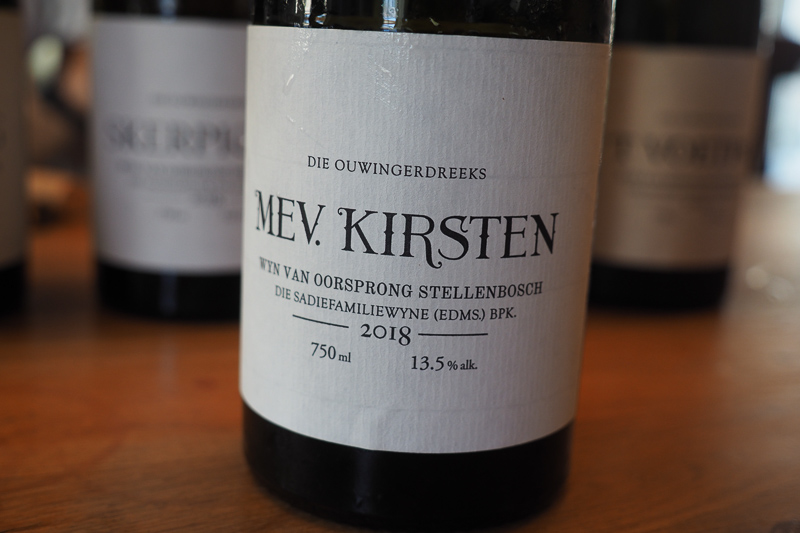
Sadie Family Wines Mev. Kirsten 2018 Stellenbosch, South Africa
Oldest Chenin vineyard planted in South Africa, planted between 1905 and 1920 on decomposed granite. This was the first old vine wine bottled by Sadie in 2006. If South Africa has a grand cru vineyard it is this, says Eben. Two soils on top of each other: decomposed granite over sandstone. So precise, detailed and mineral with lovely racy citrus and pear fruit. This has a beautiful grainy structure and amazing freshness and purity. So linear and bright, with many layers of flavour. So thrilling. 97/100 (JG)
This comes from the oldest Chenin Blanc vineyard planted in South Africa, planted from 1905 to the 1920s on decomposed granite over sandstone at the foot of Bothmaskop Mountain in Stellenbosch’s Jonkershoek Valley. Striking wild lemon, verbena, and tight lemon pith are layered with quince, green apple and yellow apple, with fine salts woven throughout. Fantastic complexity, this opens to reveal layers upon layers. 95/100 (TR)
Sadie Family Wines Palladius 2017 Swartland, South Africa
Complex and layered with some rich pear and peach notes. So vivid with nice depth and some citrus brightness, as well as a touch of cream, spice and a mineral twist. Has some honey, and nice orange peel detail. Has nice freshness and focus. Fine toasty notes and some structure, too. Lovely stuff. 94/100 (JG)
A blend of vineyards and soils: Paardeberg Granite (13 vineyards), Sandstone (4 vineyards). Palladius includes vines planted from 1935 – 2014, and CheninBlanc, Grenache Blanc, Marsanne, Colombar, Palomino, Semillon, Roussanne, Verdelho, Clairette Blanche, and Viognier. This undergoes native fermentation and resting for 1 year in clay amphorae and concrete eggs before moving into older foudres for an additional year. Deep layers of lemon pith, quince, golden apple, mandarin is seasoned with ample salts and fine orchard spicing. Fine grippy spicing braces the sides of this structural, bigger white. 94/100 (TR)
Older notes on wines (September 2018)
Sadie Family Podadder 2017 Swartland, South Africa
Cinsault. Supple and fine grained. This is a lovely lighter-style red with some softeness of texture and strawberry and red cherry fruit. Has fine spiciness and lovely elegance with a hint of liquorice. 94/100 (JG)
Sadie Family Treinspoor 2017 Swartland, South Africa
Tinta Barocca. Supple and fresh with nice green hints and real elegance to the red cherry and berry fruit. Juicy and linear with fine spiciness and some meaty hints. A fresh, expressive wine. 94/100 (JG)
Sadie Family Columella 2016 Swartland, South Africa
Very bright and structured with lovely density but also some freshness. Shows raspberry, blackcurrant and black cherry fruit with good freshness and detail. 95/100 (JG)
Sadie Family Skerpioen 2017 Swartland, South Africa
Linear, bright and fresh with some pithy notes and bright citrus and pear fruit. Youthful and taut with good acidity. 94/100 (JG)
Sadie Family T’Voetpad 2017 Swartland, South Africa
Fine-grained and expressive with pure citrus and pear fruit. Nicely focused with good acidity. Fresh with some grapefruit notes and a fine-grained structure. 95/100 (JG)
Sadie Family Palladius 2016 Swartland, South Africa
Clay and concrete only, then foudre for the second year. Fine and expressive with a grainy mineral core. Notes of citrus and pear with a bit of apple. Lovely detail here. 95/100 (JG)
Find these wine with wine-searcher.com
See also: part 1, in the vineyard, with Eben – a viticulture tutorial


